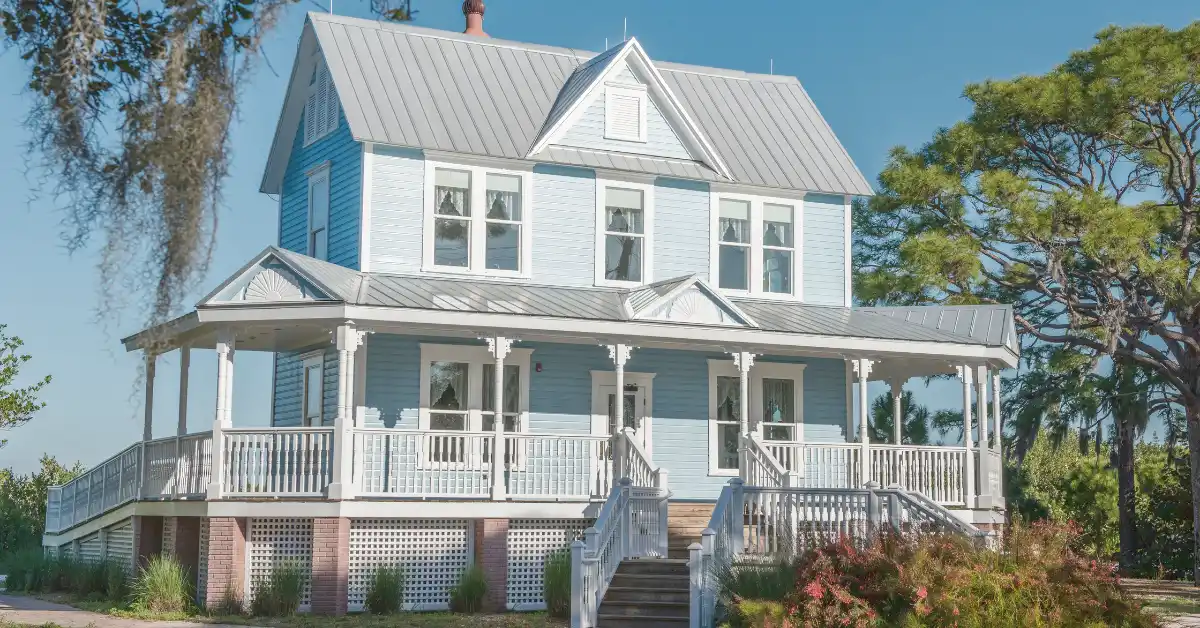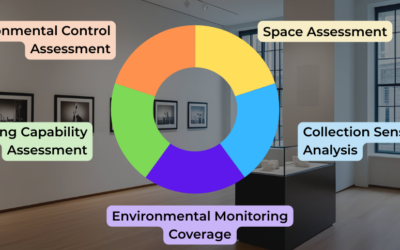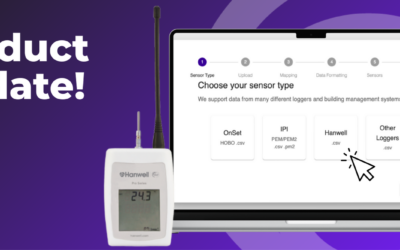How can museum technology help you with preservation in historic properties? One of the major frustrations we have heard from talking to users and potential customers for Conserv is:
We don’t have HVAC systems. What’s the point of monitoring if there’s nothing we can do about it?
While it is true that many historic properties face this particular challenge, it is not true that there is nothing you can do about it. There are many important issues that should not be overlooked even when building-wide mechanical controls are not available.
In this article, we will explore how museum technology can help historic homes achieve their preservation goals, especially in cases where they lack modern environmental control systems such as heating, ventilation, and air conditioning (HVAC).
Why monitor historic properties?
Historic properties have a set of particular characteristics and challenges that other types of institutions do not have to grapple with. Some of them include:
- A wide range of materials in the collection.
- No storage space as the whole collection is on display as part of the property.
- Old buildings which cannot be easily remodeled or refitted and which may not conform to modern safety standards and requirements.
- Permeable buildings that are very sensitive to the outside weather.
- No HVAC systems.
- A very limited staff, sometimes even just one person.
- Legacy issues related to inventory and cataloging – sometimes incomplete or inexisting.
- Extremely limited budget.
So why is monitoring the environment so important? Let’s talk about options based on different parameters.
Temperature and relative humidity
Precisely because of the impermeable nature of the building, monitoring different spaces will be able to provide the information necessary to figure out where the most offending areas are located. Monitoring can allow for a slow but continuous improvement of the building envelope by tackling spaces one at a time starting with the most permeable areas.
For more urgent matters, we recently attended an Emergency Response workshop at the ARCS 2023 conference with Rebecca Kennedy, from Curae Collections Care. One of the case studies we saw involved a pipe bursting in a historic property. The water flooded the whole second floor, started dripping through to the first floor through the flooring, and even completely collapsed the floor/ceiling between two floors. The event was not noted until 8am the next morning on a working day. This disaster would have happened regardless of whether the property had HVAC or not, and the damage would probably have been controlled at an earlier stage if there had been a real-time alert for a sudden spike in relative humidity. And while we hope we never have to deal with this, a real-time alert for a sudden rise in temperature might also help attend a fire sooner rather than later. If you are worried about the possibility of having a water emergency, check out our free webinar with Rebecca Kennedy.
Light
Here is a parameter that has nothing to do with your HVAC system. Monitoring the light levels in the different rooms of your building will let you make decisions about closing blinds, installing simple covers for sensitive items, or even moving objects away from the areas which receive the most light exposure during the day. Light exposure will also be dependent on your lighting system and the season of the year. Perhaps a good light monitoring system will be enough to convince the property owner that it’s worth investing in a change in types of lighting.
Pests
A good Integrated Pest Management system can make the difference between having to hire for an anoxia service and having to deaccession a list of destroyed items. If you are not sure how to go about this, check out our IPM webinar course and review some of the fantastic resources on Museumpests.net. Don’t forget that Conserv Cloud has an IPM feature which you can also use to keep track of your pests.
We have no HVAC, so what’s the point?
You are not alone. In fact, you are probably in the majority. Most museums around the world probably do not have HVAC. While this is an educated guess because it is not possible to get exact numbers, we have based this statement on the following factors:
- Chances are most collections around the world which are not in the Global North (namely Europe, North America, Australia) cannot afford to have mechanical control systems. We can say this definitely about Peru, from the personal experience of our Conservation Liaison, Angelica, and she is pretty confident about extending this expectation to the rest of Latin America.
- Even taking into account the Global North, most collections around the world are not in major museums but in smaller institutions, which again, generally can’t afford air-handling units (AHUs) or building-wide HVAC systems.
- Even if you feel your environment is just absolutely terrible, and you can’t fix the windows, and you have no budget to buy de/humidifiers, and there are moths in your attic and mold in your basement – remember environmental data that actually shows this will help you argue for improvements. Your anecdotal oral experience may never be as convincing as your graphs and your images. Put it in a report and elevate it to management. You can literally use your “bad environment” data to get the funds you require to turn it into good environment data, or to negotiate when resources are allocated among different departments and you need to sell your case.
The fact that many institutions do not have environmental control systems does not mean that they are incapable of taking care of their collections. In fact, the resourceful and creative staff in many of these places have figured out passive or minimally active ways to navigate their environments in ways that keep their collections safe and their energy bills small. These can include actions such as opening windows and doors, maintaining ventilation, and using storage-based microclimates. In 2023, when the sustainable museum is at the forefront of development, all institutions regardless of size and budget are encouraged to reduce their carbon footprint by finding passive and minimally active ways to protect their collections.
A lack of mechanical control systems does not automatically mean you have no agency or power over your collections environment.
Regardless of your HVAC capabilities, environmental monitoring data collected by reliable and available museum technology can lead to the planning and implementation of practical preventive conservation measures such as ventilation, shading, use of portable de/humidifiers, relocation or rehousing of collection items and decision-making for conservation treatment priorities.
If you think about it again, if you don’t have HVAC, you probably need environmental monitoring even more. Why? Normally, if you have an HVAC system, there will also be some sort of facilities team or person whose job it is to keep track of it. That means that, in some way, they are monitoring your environment for you and could let you know if things go awry. But if you don’t have HVAC, then you definitely do not have anyone at all monitoring anything related to the environment on your property – so it really is entirely up to you to figure things out.
And then you have visitors too. Monitoring can help collection specialists understand how visitors may affect the conditions of historic homes. People can increase the temperature and humidity levels in spaces by their body heat and respiration. They can also introduce dust, dirt, pests, and pollutants from their shoes and clothing. By tracking visitor numbers and movements, museum professionals can optimize visitor flow and management strategies to minimize the impact on the historic homes.
How can museum technology help historic properties with preservation?
One of the main challenges that many historic homes face when it comes to preservation is how to balance the need for environmental control with the respect for historical authenticity. Many historic homes were built before the invention of modern HVAC systems, which means that they rely on natural ventilation, heating, and cooling methods such as windows, doors, fireplaces, fans, or curtains. These methods may not be sufficient or appropriate to maintain optimal environmental conditions for the preservation of artifacts and structures.
Museum technology can help historic properties overcome this challenge by providing them with tools to monitor and manage their environmental conditions without compromising their historical integrity. For example:
- Sensors and data loggers can measure various parameters such as temperature, humidity, light, air quality, and movement. These devices can transmit the data wirelessly to a central database or dashboard where they can be stored, analyzed, visualized, or shared.
- Data analysis software can help identify trends, patterns, anomalies, or risks in the environmental data. This can help inform decision-making on how to adjust or improve the environmental conditions or implement preventive or corrective actions.
- Alerts and notifications can be set up to warn staff or decision makers of any significant changes or issues in the environmental data. This can help prevent or mitigate potential damage or deterioration of artifacts or structures.
- Reports and recommendations can be generated based on the environmental data. These can help evaluate the effectiveness of the current preservation strategies or suggest new ones.
Environmental monitoring in historic properties can be challenging due to the unique nature of the buildings. Here are some strategies that can help you overcome these challenges while you wait for your grant funding to arrive:
- Identify the environmental factors that need to be monitored: The first step is to identify the environmental factors that can affect the preservation of the historic property and set your monitoring goals. These factors can include temperature, humidity, light, air quality and other factors you have to monitor, known as the agents of deterioration that threaten collections. You probably already know exactly what your biggest challenges are, so you can start there.
- Choose the right monitoring equipment: Once you have identified the environmental factors that need to be monitored, you need to choose the right monitoring equipment. The equipment should be able to measure the environmental factors accurately and should be compatible with the historic property. Don’t forget to think about networking issues for wireless capabilities.
- Develop a monitoring plan: A monitoring plan should be developed to ensure that the environmental factors are monitored regularly. The plan should include the frequency of monitoring, the location of the monitoring equipment, and the personnel responsible for monitoring. Don’t forget to include your purpose for monitoring and avoid collecting data for the sake of collecting. The data is only there to help you make decisions. Remember that you cannot change or improve what you haven’t measured, but if you know some problems in your building or have noticed some changes and damages in collections, those can be your starting point.
- Take corrective action when necessary: If the monitoring equipment detects any changes in the environmental factors that can affect the preservation of the historic property, corrective action should be taken immediately. This can include setting up portable de/humidifiers, closing blinds, moving collections, changing light sources, etc.
- Train personnel: Personnel or even volunteers responsible for monitoring the environmental factors should be trained on how to use the monitoring equipment and how to take corrective action when necessary. In the case of Conserv Cloud, for example, you can take a quick free course on how to use the platform.
- Leverage your data: Remember that solid environmental monitoring data can be attached to grants and project proposals for the benefit of your collections. Use your data to argue for the budget you need to fix those windows, replace those pipes, hire that pest management contractor, buy better storage solutions, etc.
How to use IoT data loggers for monitoring historic homes?
IoT data loggers are devices that can measure and record environmental parameters wirelessly and transmit them to a cloud-based platform for storage and analysis. IoT data loggers have several advantages over traditional data loggers for monitoring historic homes.
- They are small, discreet, and battery-powered, which means they can be easily installed in various locations without disturbing the aesthetics or integrity of the historic homes. Conserv loggers have long-lasting batteries that should not require replacement before your sensors are renewed.
- They can provide real-time data that can be accessed remotely from any device with an internet connection. This allows museum professionals to monitor the conditions of historic homes anytime and anywhere. In the case of Conserv, you get unlimited users so you can share data with as many people as you need.
- You can program them to generate alerts and notifications when the parameters exceed or fall below certain thresholds. This will allow you to react quickly and take corrective actions before any damage occurs.
- If you decide to use LoRaWAN, your connectivity and coverage will be higher than with Wi-Fi or Bluetooth solutions, so you will need fewer gateways for your sensors and may even be able to monitor separate buildings with a single gateway.
If you’d like to read more about historic properties using modern data loggers for environmental monitoring, check out our case study on Monitoring Temperature and Humidity in the Most Humid City in Florida.
Conclusions
Museum technology can be a powerful ally for historic properties in their quest to preserve their collections and structures for posterity. By using museum technology to monitor and manage environmental conditions, historic buildings can ensure that they provide preventive care and protection for their artifacts and buildings without compromising their historical authenticity or integrity.
Environmental monitoring is even more critical in spaces where mechanical control is not installed as there will be no other systems monitoring the spaces. Historical properties can be particularly vulnerable to disasters caused by the aging building structures, so that real-time monitoring can be a true lifesaver.
If you have any questions about environmental monitoring, integrated pest management, or just want to talk about preventative conservation, please reach out to us! Don’t forget to check out our blog or join our community of collections care professionals where you can discuss hot topics, connect with your peers or even take a course to get familiar with the Conserv platform.





